How TrainerRoad Builds Adaptive Training Plans for You
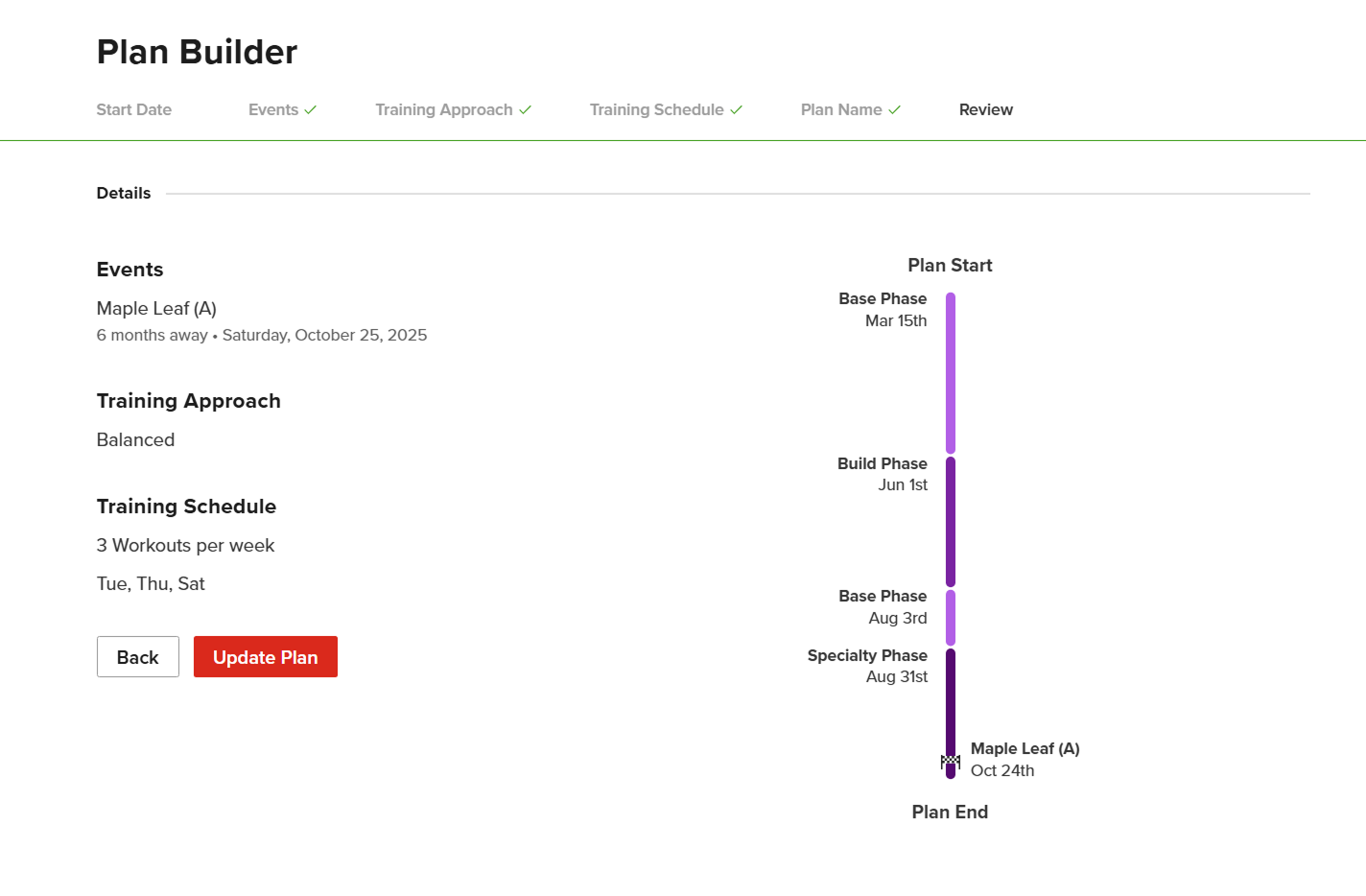
TrainerRoad’s Training Philosophy
TrainerRoad’s training philosophy provides the backbone for every plan. This philosophy emphasizes:
- Consistency: Training regularly is the cornerstone of sustainable fitness improvements.
- Sustainability: Avoiding burnout ensures progress over time without setbacks.
- Targeted Workouts: Every workout is carefully designed to target specific power zones & energy systems to maximize performance gains.
To do this, TrainerRoad training plans utilize proven, science-backed approaches including Classical Periodization & Supercompensation to help you effectively build fitness and achieve your cycling goals.
What is Periodization in Cycling?
Periodization is a concept that implies evolving training structure and focus during a plan. Classic Periodization organizes training into structured cycles: macrocycles, mesocycles, and microcycles. These develop your fitness, maximize adaptation, and prevent long-term fatigue.
The Structure of a TrainerRoad Plan
Macrocycle: Your overall training plan is called a macrocycle. TrainerRoad divides your macrocycle into three distinct phases: Base, Build, and Specialty.
- Base Phase: This phase builds your aerobic fitness and endurance through structured, lower-intensity workouts. It prepares your body for more intense training later by improving your efficiency and endurance.
- Build Phase: This phase includes higher-intensity workouts designed to boost your Functional Threshold Power (FTP) and overall power. Structured intervals target specific energy systems, leading to improvements in speed, stamina, and strength.
- Specialty Phase: This phase focuses training specifically on your goals or events, such as increasing FTP, riding a century, racing a crit, or competing in a triathlon. Workouts refine your fitness, sharpen event-specific skills, and prepare you for optimal performance.
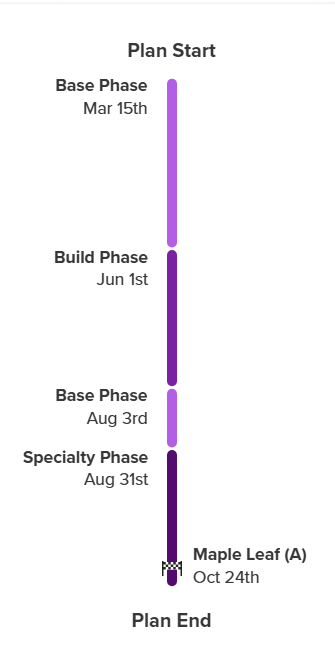
Balancing Volume, Intensity, and Recovery
The phases are broken down into mesocycle usually lasting 3-4 weeks. At the end of each mesocycle there is a period dedicated to recovery. Recovery is essential for your body to adapt and get faster from training.
Regularly scheduled recovery weeks and easier workout days help your body effectively adapt to training stress, ensuring continuous improvement while preventing setbacks. This structured balance allows you to train sustainably and consistently, maximizing performance gains.
How is Personalized Volume Determined?
TrainerRoad’s plan building feature customizes training plan volume by considering three key factors to ensure your plan aligns closely with your individual needs and goals: Training history, goals, and training approach.
1. How Your Training History Is Used
TrainerRoad evaluates your past cycling activities to gauge your fitness and determine a sustainable training volume for you to get faster & reach your goals. Workouts with power data are automatically analyzed, and heart rate data can also inform your plan when you provide your maximum heart rate in TrainerRoad.
Example: If you’re new to structured training, you’ll likely start with a lower-volume plan to establish consistent habits before gradually increasing intensity and volume. TrainerRoad meets you where you’re at so you can reach your goals.
2. Defining Your Goals and Events
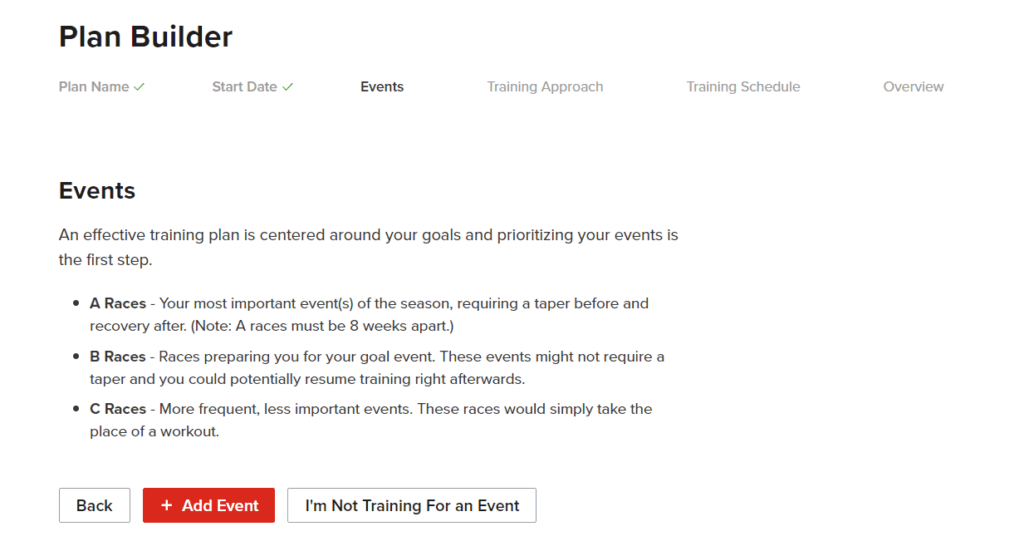
Your training goals or targeted events help determine which energy systems your plan emphasizes, following the training principle of specificity—focusing on the areas most relevant to your event.
Example: If you’re training for a Gran Fondo or aiming to improve endurance, your plan will emphasize sustained power and endurance-focused workouts.
3. Choosing Your Training Approach
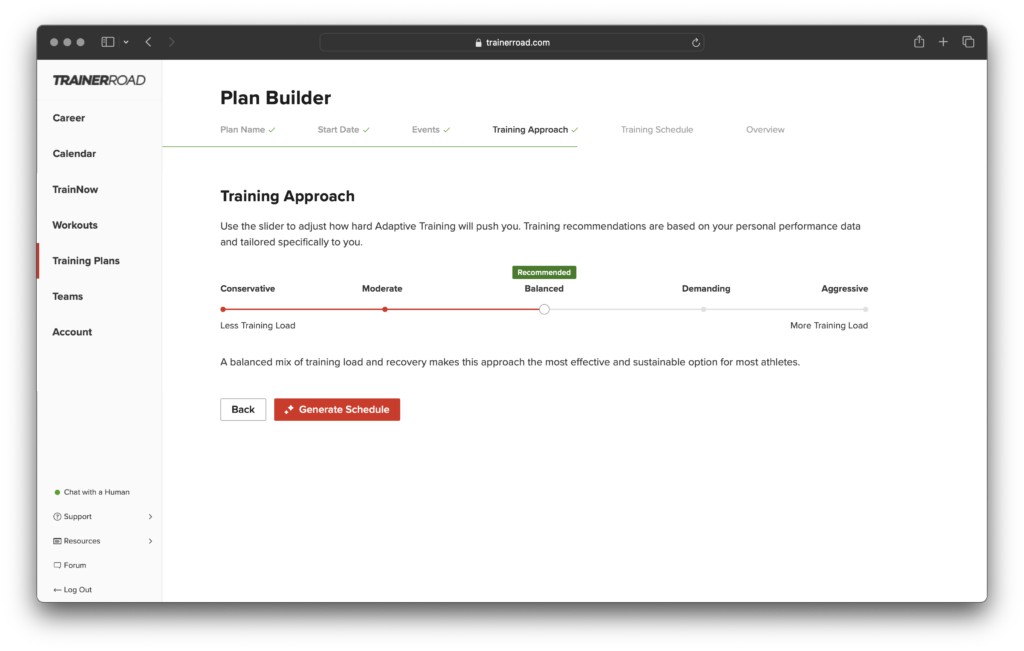
Your selected Training Approach indicates how aggressively you want to train, affecting your overall intensity and workload.
Example: Choosing a conservative approach will prioritize recovery and responds quickly to stress, helping you manage training load effectively. Conversely, an aggressive approach increases intensity and training demands.
These personalized inputs ensure your training plan precisely matches your current fitness level, goals, and desired approach, facilitating consistent progress and sustainable improvements.
Understanding Volume Recommendations
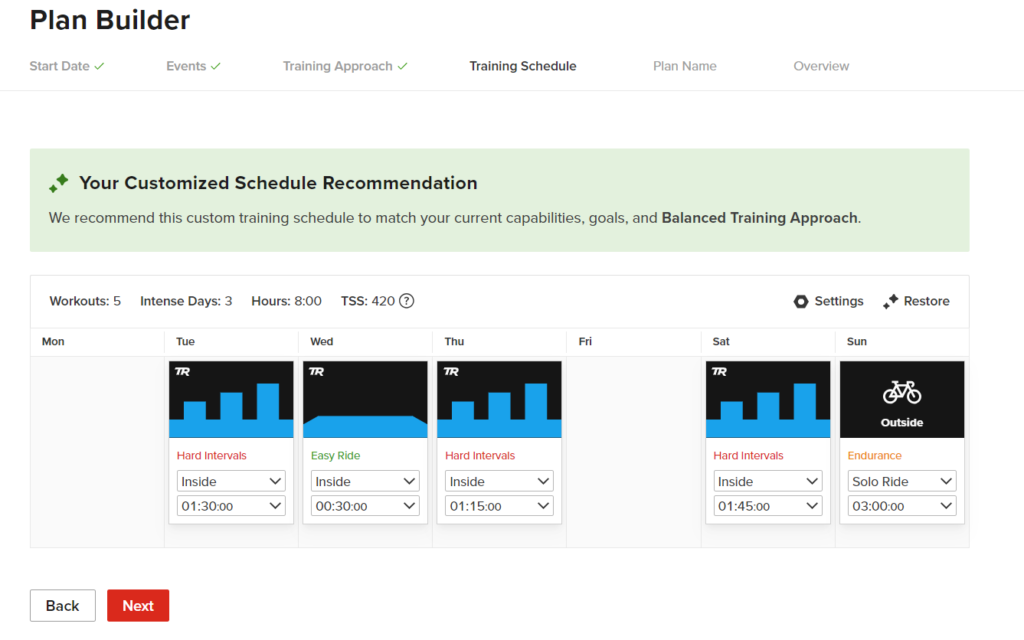
Trainer Road’s plan Builder is designed to deliver the right balance of training load and recovery to optimizing performance gains and consistency. It allows you to set the desired training approach, and builds the plan accordingly.
Fundamental to endurance training is the repetition of stimulus, recovery, and adaptation. The volume recommendations manage this loading and deloading cycle throughout a plan.
Structured vs. Unstructured Training
Not all stress is equal, and while TSS is a useful metric, Plan Builder considers more than just TSS. Structured interval training is often more demanding and requires more recovery than unstructured training of the same duration.
Because of this, your structured plan may include fewer hours or lower TSS compared to unstructured training, while still being more effective for building fitness. This is because our plans use the science backed method of supercompensation.
The Power of Supercompensation
Supercompensation is a physiological process in endurance training where the body responds to training stress by getting stronger after recovery. After a tough workout, your performance drops a bit because you’re tired. But when you rest and recover, your body not only returns to normal—it gets stronger than before to handle the stress better next time.
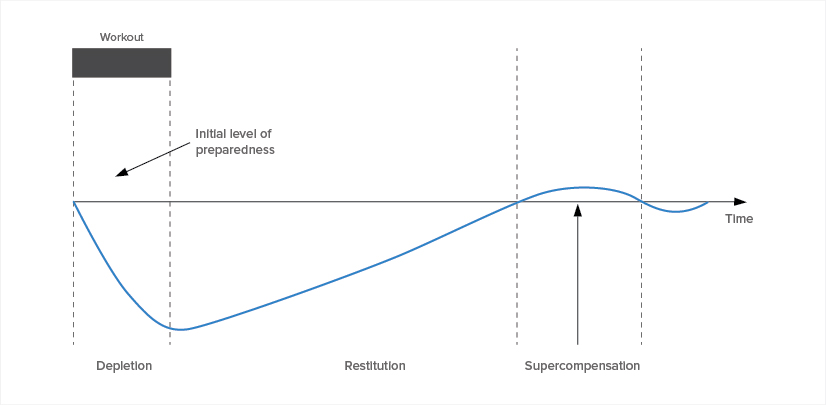

To keep improving, it’s important to time your workouts so they match the period when your body is getting stronger. This helps you build endurance (aerobic capacity), use oxygen better (mitochondrial density), and store more energy (glycogen storage).
TrainerRoad plans are designed to do this for you—balancing hard workouts and recovery to help you get the best results. TrainerRoad plans effectively leverage supercompensation, timing your intensity and recovery for optimal performance gains.
In short, you can get more performance growth with less Time & TSS on a structured TrainerRoad plan compared to unstructured training thanks to applied sports science.
Dynamic Volume Recommendations
As you train, you can check your volume recommendations at any time. We recommend checking your recommended volume when you feel like you’re ready for a change in training volume. This could be after completing a phase of your training plan, but could happen at any point in your training. Many athletes like to use it after an FTP Detection or after a recovery week.
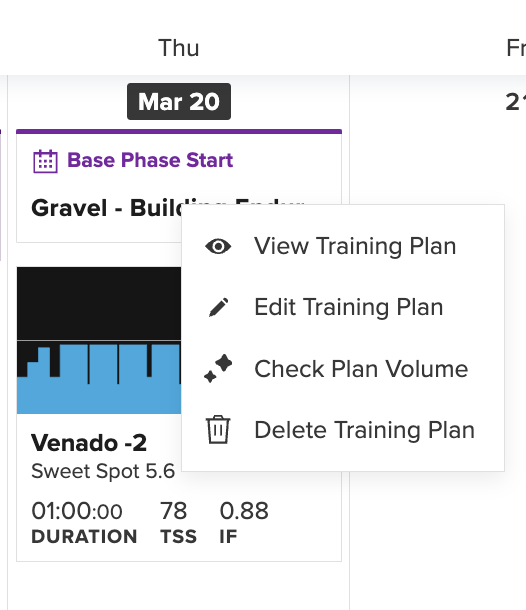
Clicking Check Volume will bring you to the Schedule step of Plan Builder, with your updated plan volume recommendation. Proceed through the rest of the plan builder tool as you normally would to update your plan. Or exit out of plan builder to keep your existing plan.
Your volume recommendation may stay the same. That means your current plan schedule is still the best for you.
How TrainerRoad Adjusts Your Training Automatically
TrainerRoad’s workout adaptations actively analyze your workout performance to ensure your training is always optimized. After each workout, TrainerRoad evaluates how effectively you completed the workout based on power data, heart rate, and your feedback on perceived exertion(RPE Survey).
Depending on your performance:
- If you’re consistently completing workouts at the prescribed intensity levels, TrainerRoad will increase the difficulty of future sessions to continue driving improvements in your fitness. The system also considers cumulative fatigue’s effect on consistency. If you do hard workouts, you may receive a future workout recommendation that has a lower workout level. This workout will still be challenging without being too much. This keeps your training productive and consistent in the long-term.
- If you’re struggling or unable to complete a workout, TrainerRoad proactively reduces the intensity and/or duration of upcoming workouts to support recovery and prevent overtraining.
Example: Suppose your recent scheduled threshold workouts have felt noticeably easier. TrainerRoad recognizes this improvement and adjusts your future sessions to include higher-intensity work or increased durations to continue improving your fitness. How it increases the difficulty of a workouts will depend on the the training phase, and the goal or target event you set.
Fatigue Detection and Long-Term Progress
TrainerRoad’s fatigue detection monitors your training to identify early signs of accumulated fatigue, helping you avoid burnout and maintain consistent progress. By assessing factors like recent workout intensity, training volume, and your subjective feedback, TrainerRoad proactively adjusts your plan.
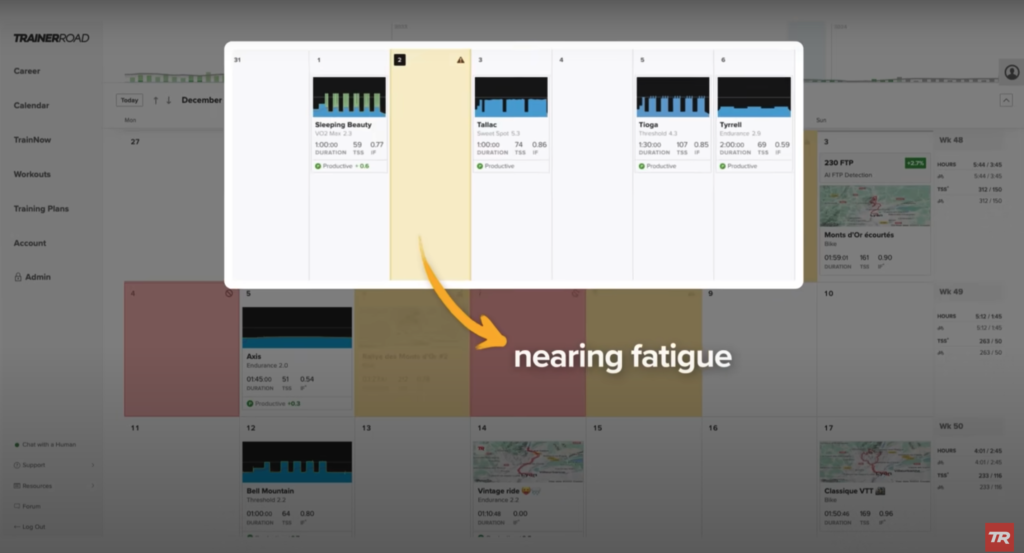
Proactive Training Adjustments:
- When early signs of fatigue emerge, TrainerRoad may reduce intensity, shorten sessions, or insert additional recovery periods into your plan to ensure sufficient rest and adaptation.
- If your fatigue levels remain manageable and your training capacity stays strong, TrainerRoad maintains or gradually increases your training load during your plan, supporting continued fitness improvements.
Example: Imagine you’re nearing the end of a challenging training block and you do a hard group ride in addition to your training. TrainerRoad detects fatigue signals and automatically introduces additional recovery-focused workouts or adjusts upcoming workout intensity downward, helping you recover and maintain consistency without losing fitness.
Together, TrainerRoad’s workout adaptations and fatigue detection ensure your training is personalized, effective, and sustainable, allowing for steady long-term improvement.
Training Built for You
Each athlete has unique needs—goals, schedule, fitness, etc. These tools work with your specific needs, to help you train consistently and sustainability so you can smash your goals, and get faster.
No matter what level of fitness you start with, TrainerRoad meets you where you are and guides you to reach your set goals. Try it for yourself risk-free for 30 days.


